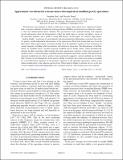Approximate waveforms for extreme-mass-ratio inspirals in modified gravity spacetimes
Author(s)
Yunes, Nicolas; Gair, Jonathan R.
DownloadGair-2011-Approximate waveforms for extreme.pdf (758.9Kb)
PUBLISHER_POLICY
Publisher Policy
Article is made available in accordance with the publisher's policy and may be subject to US copyright law. Please refer to the publisher's site for terms of use.
Terms of use
Metadata
Show full item recordAbstract
Extreme mass-ratio inspirals, in which a stellar-mass compact object spirals into a supermassive black hole, are prime candidates for detection with space-borne milliHertz gravitational wave detectors, similar to the Laser Interferometer Space Antenna. The gravitational waves generated during such inspirals encode information about the background in which the small object is moving, providing a tracer of the spacetime geometry and a probe of strong-field physics. In this paper, we construct approximate, "analytic-kludge" waveforms for such inspirals with parametrized post-Einsteinian corrections that allow for generic, model-independent deformations of the supermassive black hole background away from the Kerr metric. These approximate waveforms include all of the qualitative features of true waveforms for generic inspirals, including orbital eccentricity and relativistic precession. The deformations of the Kerr metric are modeled using a recently proposed, modified gravity bumpy metric, which parametrically deforms the Kerr spacetime while ensuring that three approximate constants of the motion remain for geodesic orbits: a conserved energy, azimuthal angular momentum and Carter constant. The deformations represent modified gravity effects and have been analytically mapped to several modified gravity black hole solutions in four dimensions. In the analytic kludge waveforms, the conservative motion is modeled by a post-Newtonian expansion of the geodesic equations in the deformed spacetimes, which in turn induce modifications to the radiation-reaction force. These analytic-kludge waveforms serve as a first step toward complete and model-independent tests of general relativity with extreme mass-ratio inspirals.
Date issued
2011-09Department
MIT Kavli Institute for Astrophysics and Space ResearchJournal
Physical Review D
Publisher
American Physical Society (APS)
Citation
Gair, Jonathan, and Nicolás Yunes. “Approximate waveforms for extreme-mass-ratio inspirals in modified gravity spacetimes.” Physical Review D 84.6 (2011): n. pag. Web. 25 Jan. 2012. © 2011 American Physical Society
Version: Final published version
ISSN
1550-7998
1089-4918